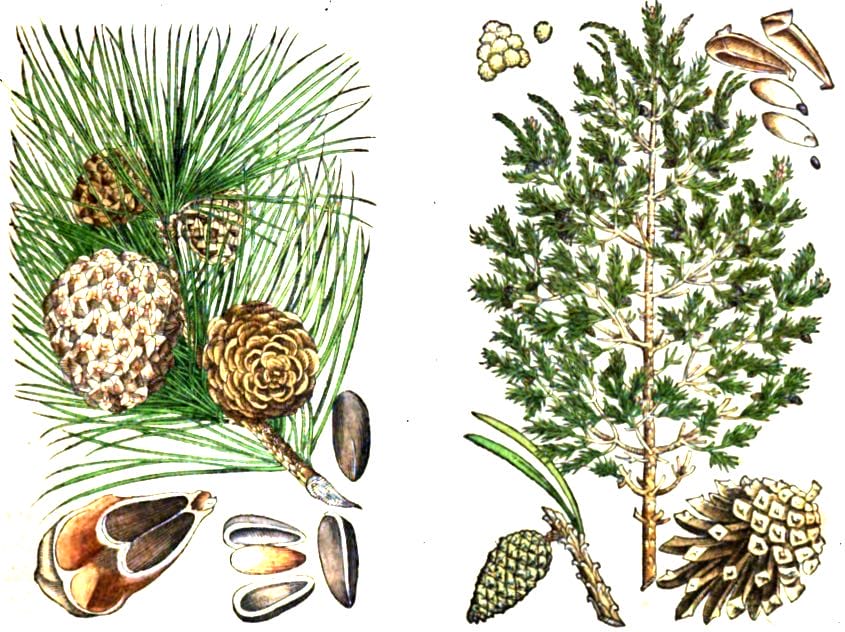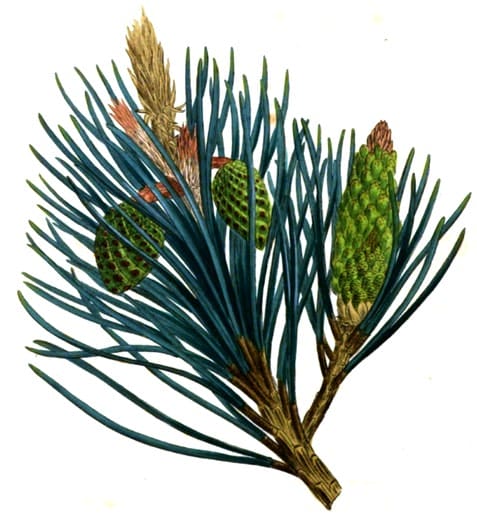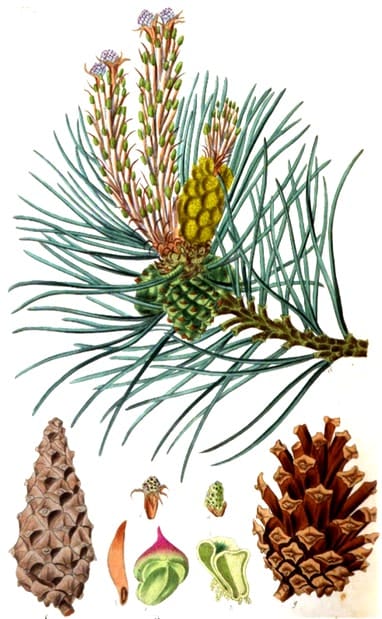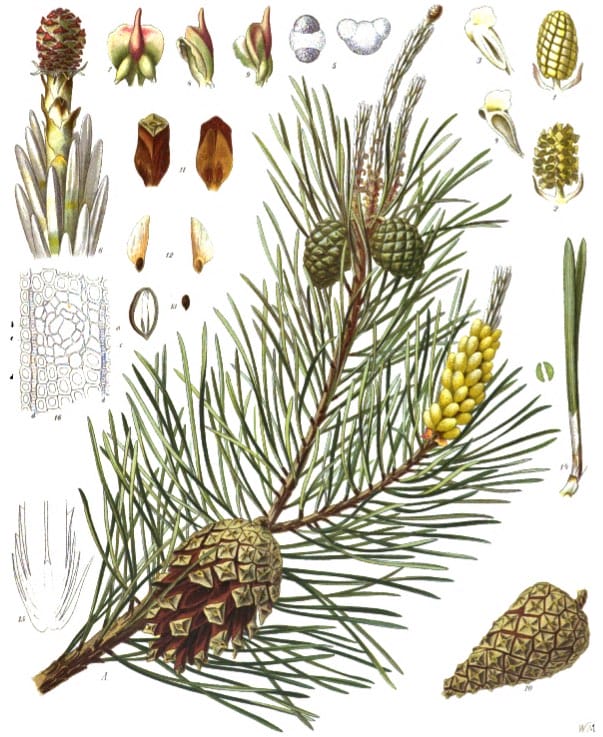Pinus, Pine tree
Wild Pine, Scotch Fir, Scotch PineTurpentine: Terebinthina communis, Terebinthina pinea
 Left: Pinus; Right: Pinus sylvestris
Left: Pinus; Right: Pinus sylvestrisKreutterbuch, Matthiolus, 1586

|

|
|
Medical Botany, Woodville, 1810 |
Medical Botany, Stevenson & Churchill, Vol II, 1831 |
 Kohler’s Medizinal Pflanzen, 1887
Kohler’s Medizinal Pflanzen, 1887Botanical name:
Pinus sylvestris
Note a number of Pinus have been used similarly.
In Tibetan Medicine, P. tabuliformis is used. P. sylvestris is an accepted substitute.
Parts used:
Leafy twigs and Turpentine
Primary source of Tar; Resin
Various commodities are made from Pine Resin:
1. Pine Resin; crude Turpentine (sometimes called rosin): the gum that exudes when the tree is cut. Syrupy, white liquid
with a disagreeable odor with an acrid, bitter, nauseous taste.
2. Spirits of Turpentine (sometimes just called ‘Turpentine’): the oil distilled from cruse Pine Resin.
3. Colophony (incorrectly), Black Resin: that which is left after distilling Turpentine. If not all the oil is distilled off, it
makes white Colophony. If all the oil is distilled off, it forms the Black Colophony (Black Resin).
4. Colophony (true); Boiled Turpentine: crude Turpentine boiled in water until it becomes the consistency of rosin.
5. Rosin: now generally means the resin left after distilling Spirit (oil) of Turpentine
6. Liquid Pitch, Tar: fat, black liquor that flows from the base of the tree when cut or ring-barked. Various conifers have
been used.
7. Dry Pitch: crude Turpentine resin boiled until almost burnt (or the resin left after distilling spirits of Turpentine)
8. Black Pitch: Colophony, heated and mixed with Tar
9. Ship Pitch: combination of Black Pitch, Resin, Suet and Tar, used to seal ships
Temperature & Taste:
Warm, dry. Pungent
Uses:
LEAFY TWIGS:
1. Clears Wind and Damp, Eases Pain:
-Arthritic and Rheumatic diseases (internally and topically)
-Edema, fluid retention
-urinary dysfunction
2. Clears Phlegm, Stops Cough:
-cold-type Cough, Asthma
-Catarrh, Colds, Laryngitis
-Scrofula, Lymphadenitis
3. Externally:
-arthritic and rheumatic diseases, lumbago (leaves in bath, Oil)
-neuralgia, pain (oil)
-acne, carbuncles, eczema, itch, scabies
-Candida
-cramps
-inflammations
COLOPHONY:
-Principally externally. plasters; glutinative, emollient
-Fills ulcers with flesh
-internally and topically for Arthritic Pain
-strengthens a weak Stomach
-eases Pain
-Urinary Ulcers
TAR, LIQUID PITCH:
-Scabs, Itch, Eczema, Ringworm etc.
-internally for Cough, Phthisic, Hoarseness
-Tar and wax as a plaster for all old aches and pains, arthritis etc.
Dose:
Of the Shoots: 2–3 grams as an infusion; Turpentine: 5–15 drops. Turpentine is used externally.
Comment:
Crude Turpentine or Pine Resin that exudes from the Pine tree has numerous uses. When distilled, it gives Oil (spirits) of Turpentine. If equal parts of crude Turpentine and Oil of Turpentine are mixed, it forms the Burgandy Pitch of the Apothecary’s, and when made more thin, was the original varnish, The Oil was important for painters, farriers and various other early industrial uses.

Main Combinations:
COLOPHONY (true):
1. Made into pills with licorice for venereal disorders (Pomet, 1748)
Cautions:
1. Oil is used cautiously internally. In some people is will cause gastric discomfort.
Main Preparations used:
Spirit of Turpentine (distilled from crude Turpentine)
1. Decoction of Pine buds:
i. Pine buds (3 handfuls), Water (1 ½ pounds). Boil a quarter of an hour in a covered vessel; add to the liquor when cold an equal amount of White Wine and express after 24 hours. Dose: 1–2 oz. (Niemann)
